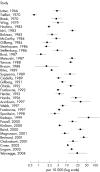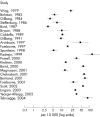Systematic review of prevalence studies of autism spectrum disorders
- PMID: 15863467
- PMCID: PMC2083083
- DOI: 10.1136/adc.2004.062083
Systematic review of prevalence studies of autism spectrum disorders
Abstract
Aim: To quantitatively examine the influence of study methodology and population characteristics on prevalence estimates of autism spectrum disorders.
Methods: Electronic databases and bibliographies were searched and identified papers evaluated against inclusion criteria. Two groups of studies estimated the prevalence of typical autism and all autism spectrum disorders (ASD). The extent of variation among studies and overall prevalence were estimated using meta-analysis. The influence of methodological factors and population characteristics on estimated prevalence was investigated using meta-regression and summarised as odds ratios (OR).
Results: Forty studies met inclusion criteria, of which 37 estimated the prevalence of typical autism, and 23 the prevalence of all ASD. A high degree of heterogeneity among studies was observed. The overall random effects estimate of prevalence across studies of typical autism was 7.1 per 10,000 (95% CI 1.6 to 30.6) and of all ASD was 20.0 per 10,000 (95% CI 4.9 to 82.1). Diagnostic criteria used (ICD-10 or DSM-IV versus other; OR = 3.36, 95% CI 2.07 to 5.46), age of the children screened (OR = 0.91 per year, 95% CI 0.83 to 0.99), and study location (e.g. Japan versus North America; OR = 3.60, 95% CI 1.73 to 7.46) were all significantly associated with prevalence of typical autism. Diagnostic criteria, age of the sample, and urban or rural location were associated with estimated prevalence of all ASD.
Conclusions: Sixty one per cent of the variation in prevalence estimates of typical autism was explained by these models. Diagnostic criteria used, age of children screened, and study location may be acting as proxies for other study characteristics and require further investigation.
Conflict of interest statement
Competing interests: none declared
Comment in
-
Two new theories of autism: hyper-systemising and assortative mating.Arch Dis Child. 2006 Jan;91(1):2-5. doi: 10.1136/adc.2005.075846. Arch Dis Child. 2006. PMID: 16371371 Free PMC article. Review.
References
-
- Fombonne E. Epidemiological surveys of autism and other pervasive developmental disorders: an update. J Autism Dev Disord 200333365–382. - PubMed
-
- Wing L, Potter D. The epidemiology of autistic spectrum disorders: is the prevalence rising? Mental Retardation and Developmental Disabilities Research Review 20028151–161. - PubMed
-
- Fombonne E. Epidemiological trends in rates of autism. Mol Psychiatry 20027(suppl 2)S4–S6. - PubMed
-
- Charman T. The prevalence of autism spectrum disorders. Recent evidence and future challenges. Eur Child Adolesc Psychiatry 200211249–256. - PubMed
-
- Fombonne E. The epidemiology of autism: a review. Psychol Med 199929769–786. - PubMed
Publication types
MeSH terms
Grants and funding
LinkOut - more resources
Full Text Sources
Miscellaneous


